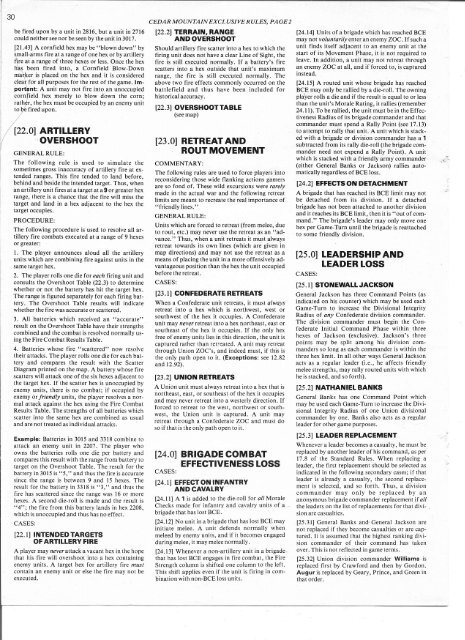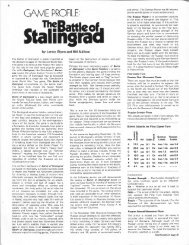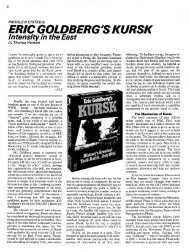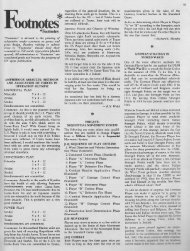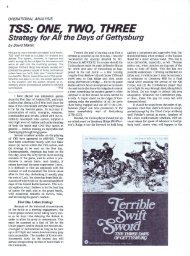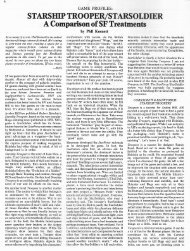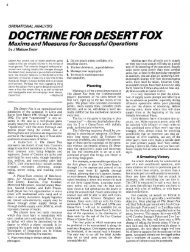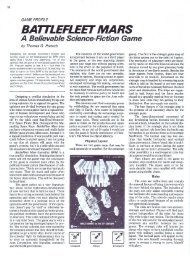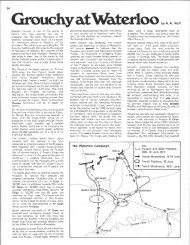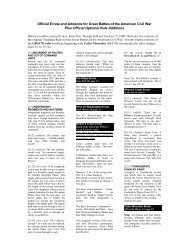Rules - Learning SPI's Great Battles of the American Civil War
Rules - Learning SPI's Great Battles of the American Civil War
Rules - Learning SPI's Great Battles of the American Civil War
- No tags were found...
You also want an ePaper? Increase the reach of your titles
YUMPU automatically turns print PDFs into web optimized ePapers that Google loves.
30be fired upon by a unit in 2816, but a unit in 2716could nei<strong>the</strong>r see nor be seen by <strong>the</strong> unit in 3017.[21.43] A cornfield hex may be "blown down" bySl~all-arms fire at a range <strong>of</strong> one hex or by artilleryfire at a range <strong>of</strong> three hexes or less. Once <strong>the</strong> hexhas been fired into, a Cornfield Blow-Downmal-ter is placed on <strong>the</strong> hex and it is consideredclea~ for all purposes for <strong>the</strong> rest <strong>of</strong> <strong>the</strong> game. lrnportent:A unit may not fire into an unoccupiedcornfield hex merely to blow down <strong>the</strong> corn;rathjr, <strong>the</strong> hex must be occupied by an enemy unit~ '::.:;:::ILLERYGENERAL RULE:.OVERSHOOTThe following rule is used to simulate <strong>the</strong>I sometimes gross inaccuracy <strong>of</strong> artillery fire at ex-I tended ranges. This fire tended to land before,behind and beside <strong>the</strong> intended target. Thus, whenan artillery unit fires at a target at a 9 or greater hexIrange, <strong>the</strong>re is a charice that <strong>the</strong> fire will miss <strong>the</strong>target and land in a hex adjacent to <strong>the</strong> hex <strong>the</strong>I target occupies.PROCEDURE:The following procedure is used to resolve all artilleryfire combats executed at a range <strong>of</strong> 9 hexesor greater:1. The player announces aloud an <strong>the</strong> artilleryunits which are combining fire against units in <strong>the</strong>same target hex.2. The player rolls one die for each firing unit andconsults <strong>the</strong> Overshoot Table (22.3) to determinewhe<strong>the</strong>r or not <strong>the</strong> battery has hit <strong>the</strong> target hex.The range is figured separately for each firing battery.The Overshoot Table results will indicatewhe<strong>the</strong>r <strong>the</strong> fire was accurate or scattered.3. All batteries which received an "accurate"result on <strong>the</strong> Overshoot Table have <strong>the</strong>ir strengthscombined and <strong>the</strong> combat is resolved normally using<strong>the</strong> Fire Combat Results Table.4. Batteries whose fire "scattered" now resolve<strong>the</strong>ir attacks. The player rolls one die for each batteryand compares <strong>the</strong> result with <strong>the</strong> ScatterDiagram printed on <strong>the</strong> map. A battery whose firescatters will attack one <strong>of</strong> <strong>the</strong> six hexes adjacent to<strong>the</strong> target hex. If <strong>the</strong> scatter hex is unoccupied byenemy units, <strong>the</strong>re is no combat; if occupied byenemy or friendly units, <strong>the</strong> player resolves a normalattack against <strong>the</strong> hex using <strong>the</strong> Fire CombatResults Table. The strengths <strong>of</strong> all batteries whichscatter into <strong>the</strong> same hex are combined as usualand are not treated as individual attacks.Example: Batteries in 3015 and 3318 combine toattack an enemy unit in 2207. "The player whoowns <strong>the</strong> batteries rolls one die per battery andcompares this result with <strong>the</strong> range from battery totarget on <strong>the</strong> Overshoot Table. The result for <strong>the</strong>battery in 3015 is "5," and thus <strong>the</strong> fire is accuratesince <strong>the</strong> range is between 9 and 15 hexes. Theresult for <strong>the</strong> battery in 3318 is "3," and thus <strong>the</strong>fire has scattered since <strong>the</strong> range was 16 or morehexes. A second die-roll is made and <strong>the</strong> result is"4"; <strong>the</strong> fire from this battery lands in hex 2208,which is unoccupied and thus has no effect.CASES:[22.1] INTENDED TARGETSOF ARTILLERY FIREA player may never attack a vacant hex in <strong>the</strong> hopethat his fire will overshoot into a hex containingenemy units. A target hex for artillery fire mustcontain an enemy unit or else <strong>the</strong> fire may not beexecuted.CEDAR MOUNTAIN EXCLUSIVE RULES, PAGE 2[22.2] TERRAIN, RANGEAND OVERSHOOTShould artillery fire scatter into a hex to which <strong>the</strong>firing unit does not have a clear Line <strong>of</strong> Sight, <strong>the</strong>fire is still executed normally. Ifa battery's firescatters into a hex outside that unit's maximumrange, <strong>the</strong> fire is still executed normally. Theabove two fire effects commonly occurred on <strong>the</strong>battlefield and thus have been included forhistorical accuracy.[22.3] OVERSHOOT TABLE(see map)[23.0] RETREAT ANDROUT MOVEMENTCOMMENTARY:The following rules are used to force players intoreconsidering those wide flanking actions gamersare so fond <strong>of</strong>. These wild excursions were rarelymade in <strong>the</strong> actual war and <strong>the</strong> following retreatlimits are meant to recreate <strong>the</strong> real importance <strong>of</strong>"friendly lines."GENERALRULE:Units which are forced to retreat (from melee, dueto rout, etc.) may never use <strong>the</strong> retreat as an "advance."Thus, when a unit retreats it must alwaysretreat towards its own lines (which are given inmap directions) and may not use <strong>the</strong> retreat as ameans <strong>of</strong> placing <strong>the</strong> unit in a more <strong>of</strong>fensively advantageousposition than <strong>the</strong> hex <strong>the</strong> unit occupiedbefore <strong>the</strong> retreat.CASES:[23.1] CONFEDERATE RETREATSWhen a Confederate unit retreats, it must alwaysretreat into a hex which is northwest, west orsouthwest <strong>of</strong> <strong>the</strong> hex it occupies. A Confederateunit may never retreat into a hex nor<strong>the</strong>ast, east orsou<strong>the</strong>ast <strong>of</strong> <strong>the</strong> hex it occupies. If <strong>the</strong> only hexfree <strong>of</strong> enemy units lies in this direction, <strong>the</strong> unit iscaptured ra<strong>the</strong>r than retreated. A unit may retreatthrough Union ZOC's, and indeed must, if this is<strong>the</strong> only path open to it. (Exceptions: see 12.82and 12.92).[23.2] UNION RETREATSA Union unit must always retreat into a hex that isnor<strong>the</strong>ast, east, or sou<strong>the</strong>ast <strong>of</strong> <strong>the</strong> hex it occupiesand may never retreat into a westerly direction. Ifforced to retreat to <strong>the</strong> west, northwest or southwest,<strong>the</strong> Union unit is captured. A unit mayretreat through a Confederate ZOC and must doso if that is <strong>the</strong> only path open to it.[24.0] BRIGADE COMBATEFFECTIVENESS LOSSCASES:[24.1] EFFECT ON INFANTRYAND CAVALRY[24.11] A 1 is added to <strong>the</strong> die-roll for all MoraleChecks made for' infantry and cavalry units <strong>of</strong> a _brigade that has lost BCE.[24.12] No unit in a brigade that has lost BCE mayinitiate melee. A unit defends normally whenmeleed by enemy units, and if it becomes engagedduring melee, it may melee normally.[24.13] Whenever a non-artillery unit in a brigade.that has lost BCE engages in fire combat, <strong>the</strong> FireStrength column is shifted one column to <strong>the</strong> left.This shift applies even if <strong>the</strong> unit is firing in combinationwith non-BCE loss units.[24.14] Units <strong>of</strong> a brigade which has reached BCEmay not voluntarily enter an enemy ZOC. If such aunit finds itself adjacent to an enemy unit at <strong>the</strong>start <strong>of</strong> its Movement Phase, it is not required toleave. In addition, a unit may not retreat throughan enemy ZOC at all, and if forced to, is capturedinstead.[24.15] A routed unit whose brigade has reachedBCE may only be rallied by a die-roll. The owningplayer rolls a die and if <strong>the</strong> result is equal to or lessthan <strong>the</strong> unit's Morale Rating, it rallies (remember24.11). To be rallied, <strong>the</strong> unit must be in <strong>the</strong> EffectivenessRadius <strong>of</strong> its brigade commander and thatcommander must spend a Rally Point (see 17 .13)to attempt to rally that unit. A unit which is stackedwith a brigade or division commander has a 1subtracted from its rally die-roll (<strong>the</strong> brigade commanderneed not expend a Rally Point). A unitwhich is stacked with a friendly army commander(ei<strong>the</strong>r General Banks or Jackson) rallies automaticallyregardless <strong>of</strong> BCE loss.[24.2] EFFECTS ON DETACHMENTA brigade that has reached its BCE limit may notbe detached from its division. If a detachedbrigade has not been attached to ano<strong>the</strong>r divisionand it reaches its BCE limit, <strong>the</strong>n it is "out <strong>of</strong> command."The brigade's leader may only move onehex per Game-Turn until <strong>the</strong> brigade is reattachedto some friendly division.[25.0] LEADERSHIP ANDLEADER LOSSCASES:[25.1] STONEWALL JACKSONGeneral Jackson has three Command Points (asindicated on his counter) which may be used eachGame-Turn to increase <strong>the</strong> Divisional IntegrityRadius <strong>of</strong> any Confederate division commander.The division commander must begin <strong>the</strong> ConfederateInitial Command Phase within threehexes <strong>of</strong> Jackson (exclusive). Jackson's threepoints may be split among his division commandersso long as each commander is within <strong>the</strong>three hex limit. In all o<strong>the</strong>r ways General Jacksonacts as a regular leader (i.e., he affects friendlymelee strengths, may rally routed units with whichhe is stacked, and so forth).[25.2] NATHANIEL BANKSGeneral BanKS has one Command Point whichmay be used each Game-Turn to increase <strong>the</strong> DivisionalIntegrity Radius <strong>of</strong> one Union divisionalcommander by one. Banks also acts as a regularleader for o<strong>the</strong>r game purposes.[25.3] LEADER REPLACEMENTWhenever a leader becomes a casualty, he must bereplaced by ano<strong>the</strong>r leader <strong>of</strong> his command, as per17.8 <strong>of</strong> <strong>the</strong> Standard <strong>Rules</strong>. When replacing aleader, <strong>the</strong> first replacement should be selected asindicated in <strong>the</strong> following secondary cases; if thatleader is already a casualty, <strong>the</strong> second replacementis selected, and so forth. Thus, a divisioncommander may only be replaced by ananonymous brigade commander replacement if all<strong>the</strong> leaders on <strong>the</strong> list <strong>of</strong> replacements for that divi- .sion are casualties.[25.31] General Banks and· General Jackson arenot replaced if <strong>the</strong>y become casualties or are captured.It is assumed that <strong>the</strong> highest ranking divisioncommander <strong>of</strong> <strong>the</strong>ir command has takenover. This is not reflected in game terms.[25.32] Union division commander Williams isreplaced first by Crawford and <strong>the</strong>n by Gordon.Augur is replaced by Geary, Prince, and Green inthat order.


